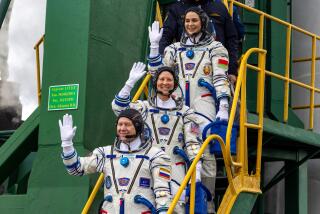Astronauts Enter Space Station to Replace Batteries
CAPE CANAVERAL, Fla. â Space shuttle Atlantisâ astronauts floated into the international space station Monday night to replace dying batteries, filling the complex with voices for the first time in a year.
American astronaut Susan Helms and Russian cosmonaut Yuri Usachev led the way into the brightly lighted Unity module. James Voss was close behind.
âGlad you left the lights on for us,â Voss told Mission Control.
The three will move into the space station for good next year. They consider this visit a brief but valuable sneak preview.
Upon entering the station from the joined shuttle, the seven crew members took air samples and checked the carbon dioxide level to make sure it was safe. They carried masks but did not need them. Everything tested fine, although the temperature was in the 80s, prompting one astronaut to strip down to his socks and a pair of shorts.
Minutes after cracking open Unity, Helms and Usachev unsealed the hatch leading into the Russian control module, named Zarya, or Sunrise. They quickly began removing the first of four bad batteries.
Since NASAâs last station visit last spring, Russian-made batteries have been conking out one by one, the result of careless overcharging. Only two of the six batteries work properly. The four bad ones will be replaced to restore full electrical power to the anemic space station.
To get to the 163-pound batteries, Helms and Usachev had to rip open the floor of the Russian control module and remove supplies stacked on top of the batteries.
Because of the racket from equipment in the Russian module, the astronauts wore ear plugs while working there. And they had small, personal fans to prevent exhaled carbon dioxide from pooling around their heads.
The last time astronauts visited the space station, they suffered nausea, headaches and eye irritation, presumably because of the stagnant air.
Russiaâs space program is picking up the tab for the batteries. Each one costs $252,000.
Before Atlantis undocks on Friday, the astronauts will also boost the sagging space station in orbit and cart over supplies.
Late Sunday and early Monday, spacewalkers Voss and Jeffrey Williams spent nearly seven hours working on the outside of the space station, fixing cranes and antennas.
More to Read
Sign up for Essential California
The most important California stories and recommendations in your inbox every morning.
You may occasionally receive promotional content from the Los Angeles Times.










